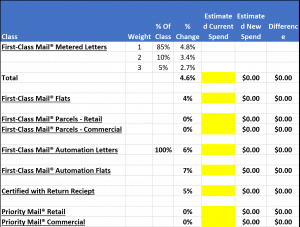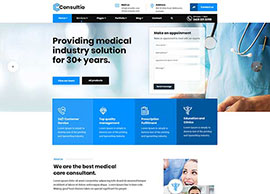USPS® is raising rates on July 9, 2023 for the fourth time in 23 months with some of the largest increases in history and at significantly higher increases than inflation. We can expect these rate spikes to continue as the USPS has stated that two increases per year will be their new norm.

Postal Advocate has been creating comparison charts for our clients that go over the changes in rates to show how it will affect budgets. The reason we do this, is to provide a true comparison versus the overall average % increase that the postal service talks about. Based on the type of mail you send, the increase could be higher or lower. Also, when you look at the new rate charts provided by the USPS®, they typically will not show the level of detail needed (Previous and new rates, side by side) to see these differences.
Hopefully, this will help you budget by seeing the impact of the most common services that you use today. At the bottom of this article there is a link to an excel tool where you can plug in your mail volumes to see the impact to your organization.
Here is a link (https://postaladvocate.com/rate-change-tools/) to a simple chart of all the rates below
First-Class Mail® Single Piece – 3% – 7% Increase


The price of a stamp First-Class Mail® Single Piece letters and Metered letters are seeing a $.03 increase to $.66 and $63. A single piece flat is increasing from $1.26 – $1.35, but the additional ounce rate is staying the same at $.24. Postcards are seeing the largest increase at $.03 or a 6% change.
First-Class Mail® Commercial – 1% – 21% Increase

Automation letters are going up 6% and Flats by 7-21%. The largest increases are at the highest sort levels which will impact most large volume mailers dramatically.
With any increase, it becomes more important to look for ways to reduce costs. These are the options available:

- Use Meters or Online Postage to save $.03 on letters.
- Consider presort services if you run over 500 pieces per day or have one-time mailings over 1000 pieces.
- Automating your mailings in house or through third party mail services to have drastic postage savings.
- Presort and automation levels go up to 3.5 ounces for the same base rate.
- Flats and postcards can have the same automation rates as letters.
- Consider moving generic content mail from First Class to Marketing Mail®
Marketing Mail® (Formerly called Standard Mail) – 6-45% Increase

Marketing Mail® Letter rates are increasing at approximately 6-8% while Flats are going up at 7-10%. The biggest change is occurring with heavy weight flats over 4 ounces. With these items there is a per piece and per pound rate needed to calculate the rate. As you can see from the chart below, the per piece rate is going up 68-317% while the per pound rate is going down by 18-24%. The net of this is as follows:
- 4-7 Ounce – 24-45% increase
- 8-10 Ounce – 15-25% increase
- 11-13 Ounce – 9-13% increase
- 14-15.99 Ounce – 5-11% increase

The best way to save money is to move mail closer to its final location utilizing destination entry level discounts. The savings for letters are increasing to 17% where Flats are holding at the DSCF level but increasing the DNDC by 3%. Again, heavy weight flats are taking a hit with the savings derived from Destination Entry Discounts being reduced by over 74%! The Post Office is sending a clear message that they are pushing people away from heavy weight flats.

USPS Competitive Services
The good news is Priority Mail® and Priority Mail® Express are not changing rates. We expect they will increase with the January 2024 rate increase, similar to what occurs with UPS and FedEx.
New Service – USPS Ground Advantage™
The USPS has announced a new service that will replace the following three existing services:
- USPS First-Class Package Service® – Same rates as current
- USPS Parcel Select Ground® Service
- USPS Retail Ground® Service
These are the parameters:
- 2 – 5 day delivery service throughout US
- 4 ounce – 70LB in weight – One standard service regardless of weight
- $100 of insurance included – can be expanded up to $5,000
- Customers can use USPS Ground Advantage Return service
- Up to 80% savings over Priority Mail – 32% savings for items 10LB and less
- Retail and Commercial versions – 26% savings for Commercial 10LB and less
We think this service will be a huge win for the USPS and provide more options to clients. First-Class Package Service® was one of their fastest growing because it had ounce rates vs. other services that were by the pound. We did not see typical clients utilizing the other ground services and clients would default to Priority Mail when items were heavier. Now there will be another option that clients can use for significant savings that can be competitive against the private carriers.
The best way to reduce costs in this area is to convert your items from Retail to Commercial Base rates. You must process your items through an online postage solution that can generate a 4X6 shipping label with the address, barcode and return address embedded. USPS.com only allows for Retail rates so you will need to look at third party solutions that start at about $15 per month. These average savings for items less than 10 LB’s (The most common for the USPS) is the following:
- Priority Mail® – 19% Savings
- Priority Mail® Express – 14% Savings
- Ground Advantage – 26% Savings
Additional Rate Change Items




Conclusion
20-55% increases in 23 months is unheard of and is impacting every organization. Mailers are going to need to look for savings strategies to help offset these changes. Our recommendation is to create visibility to all mailings and look for automation methods where applicable to reduce the cost and streamline production.
To budget for this increase, you need to look at the type of items you are sending, and the weight and zones that are most common, to truly estimate the impact. We have developed a Microsoft Excel-based budget calculator that you can download for free (https://postaladvocate.com/rate-change-tools/) that should help you better plan for this year. Some of the most popular USPS classes are going up at the highest rates but luckily there are ways to help mitigate this through automation and technology.
















































